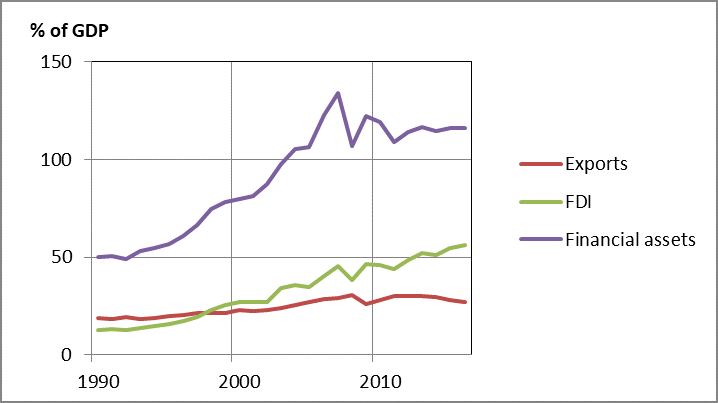It’s not just Turkey—from India to Indonesia, external financial liabilities are a looming threat
In the past weeks, Turkey’s financial crisis has captured international headlines. The Turkish lira fell at one point by as much as 30% against the U.S. dollar[1] and the economy was at risk of cuts and redundancies under the pressure of large dollar-denominated external debts.
Since 2003 the country had placed itself in a weak strategic financial position by running large current-account deficits financed by a continuous inflow of financial capital. This strategy now appears to be in grave peril.
The fall of the lira since late July was accompanied by 9% declines in the currencies of South Africa and Argentina. Longer term it remains unclear whether other major emerging economies, including India, will face similar risks.
This research brief re-visits the issue of the instability of international capital flows, specifically, portfolio investment and other investment. Here we exclude foreign direct investment (FDI) which, by comparison with other financial flows, is relatively stable because it usually represents a sizeable, longer-term investment in a foreign economic asset.
Reserves are held in dominant foreign currencies, such as the US dollar, precisely in order to counteract the periodic rapid outflows of portfolio and other investment or widening current-account deficits.
The Rising Importance of Financial Flows
Historically, both FDI and financial investments have been rising in importance. We use data from the CAM (Cambridge-Alphametrics Model) to compare the trend rates of growth for exports, FDI and financial assets for the period from 1990 to 2016 to highlight the very rapid growth in international financial assets during this period (see Figure 1).
Between 1990 and 2016 exports of goods and services increased only modestly, from 19% of world GDP to 27%—having declined, in fact, relative to GDP in recent years. FDI has increased more steadily and markedly, jumping from 12% of World GDP in 1990 to 56% in 2016—the latter its highest historical level.
But portfolio and other investment and reserves, taken together, have exhibited the largest increase. In 1990 they represented 50% of world GDP and by 2016 they had more than doubled to 116%. However, this level still represented a modest decline from the 134% registered in 2007—before the outbreak of the global financial crisis.
Figure 1. Trends in Exports, FDI and Other Financial Assets (1990-2016)

Source: WD Database 11.1
External Financial Liabilities of Emerging Economies
Major Emerging Economies such as Turkey have been the main recipients of financial flows from developed-economy financial centers (e.g., the U.S., U.K. and Europe) to the developing world. Table 1 highlights the resulting financial liabilities of eight major emerging economies, including Turkey. With the exception of South Africa, these economies rank among the 20 largest in the world.
Table 1: External Financial Liabilities
(% of External Financial Assets) for Major Emerging Economies
| Major Emerging Economies | % of Financial Assets 2012-2016 | % of Financial Assets 2022-2026 |
| Brazil | 152 | 167 |
| China | 33 | 57 |
| India | 154 | 355 |
| Indonesia | 191 | 119 |
| Mexico | 150 | 129 |
| Russia | 67 | 66 |
| South Africa | 100 | 157 |
| Turkey | 243 | 290 |
Note: Financial Assets include Reserves but not FDI
The table shows that during the period 2012-2016 Turkey had total external financial liabilities averaging 243% of its total external financial assets—the highest level of liabilities among our eight major emerging economies. This net position would suggest that Turkey’s central bank has little real control over the country’s interest rate or its monetary policy in general.
Brazil, India, Indonesia and Mexico found themselves in a similar financial position. The ratio of External Financial Liabilities to External Financial Assets was 152% for Brazil, 154% for India, 191% for Indonesia and 150% for Mexico. In contrast, both China and Russia looked much stronger financially. They had relatively small ratios, i.e., 33% for China and 67% for Russia.
Using the CAM macro-econometric model, we also attempted to project for the five-year future period of 2022-2026 what such a net external financial position would likely be for our eight major emerging economies. If we are to judge by these projections, then Brazil, India, South Africa, and Turkey are likely to have the most disadvantageous financial positions.
Notably, Turkey is projected to have one of the worst positions. The ratio of its external financial liabilities to its external financial assets is expected to rise from an already high level of 243% to an even higher 290%. India, in the absence of a major growth slowdown, is expected to be in a much worse position. Its ratio in 2022-2026 would be 355% compared to a historical average of 154% during 2012-2016.
South Africa’s future financial exposure would also worsen, rising to 157% during 2022-2026. Finally, Brazil is projected to still have a ratio over 150% in 2022-2026.
In contrast, both China and Russia are expected to maintain relatively low ratios. Fortunately, both Indonesia and Mexico are projected to significantly lower their ratios but these would still exceed 100%.
Concluding Remarks
Turkey’s current economic crisis reminds us that there remain a significant number of major emerging economies that have become highly reliant on receiving continuing financial inflows to close the gap in their external accounts. The Asia financial crisis of 1997, the Global Financial Crisis of 2007-8 and ensuing bouts of instability affecting major emerging economies also warn us that such “financial investment” by investors in rich countries remains a pervasive and serious economic problem for developing countries.
[1] The lira exchanged at 0.20666 US dollars late July and fell to a lowest point of 0.14269 US dollars at the market close on 13th August.




